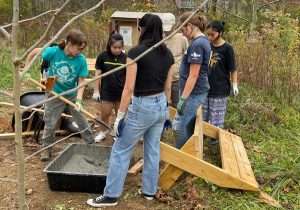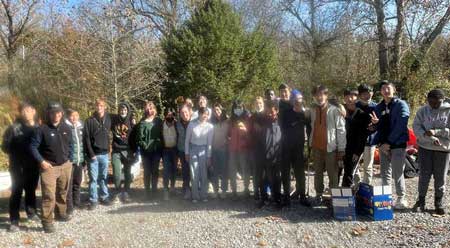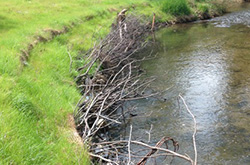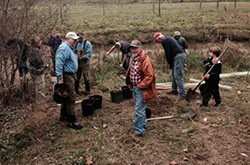SVTU Participates With Beaver Creek Projects
Restoration Projects

Beaver Creek is one of the largest limestone streams in Maryland. Originating as a freestone stream on the west slope of South Mountain, the majority of the flow during the summer months is influenced by the numerous springs in the Hagerstown Valley. The largest spring (~11,356 l/min) influencing Beaver Creek is used as the water supply for the Albert Powell Trout Hatchery. Upstream of the spring’s influence, Beaver Creek is considered a warm-water stream and flows underground much of the year due to local Karst geology.
In January 2004, approximately one mile of Beaver Creek—formerly under the control of the Antietam Fly Anglers—was established as a catch-and-return fly-fishing-only area open to the public. This area extends from the mouth of Black Rock Creek (downstream) to the upper boundary of the Perini property, approximately 161m above Beaver Creek Road. The special regulation area is entirely on private property. This area is now managed for wild trout due to favorable year-round water temperatures and some natural reproduction of brown trout.
In August there was a devastating fish-kill on Beaver Creek. We lost a large population of our large adult trout and it has set us back several years. You can learn more at the end of the page.
SVTU Contributes to Beaver Creek Projects
Starting in 2004, SVTU has been actively involved in helping with the Beaver Creek restoration project. During this time our chapter has purchased trees, provided funds and volunteered hours of labor to help with the restoration efforts.
Devastating Fish Kill on Beaver Creek
On Monday, August 7, a heavy thunderstorm with lighting, high winds, and hail moved through the Beaver Creek area, east of Hagerstown. The storm deposited a tree in the Creek and dropped 2.5 inches of rain. The next day, a fisherman and Maryland Department of Natural Resources (DNR) staff, who coincidentally happened to be at the stream, started reporting dead adult brown trout. As the day progressed, it became clear that there was a devastating fish kill that basically wiped out the adult brown trout population in the fly fishing only section of Beaver Creek. There were many dead fish, from 4 to 22 inches found, but most would have been washed downstream in the high water following the heavy rain, so it is unknown how many fish remain and how many perished.
As of Wednesday, DNR and Maryland Department of the Environment (MDE) are investigating the cause of the fish kill. We do not know much at this time, but we do know that temperature monitors in the stream do not indicate a temperature spike as the cause.
Fish and water samples are being sent to laboratories for a more complete analysis, and hopefully the tests will confirm a cause. We do not know if this was a surge of something and the water is now fine or if the storm washed a persistent pollutant into the stream that would affect fish health for weeks, months, or even years.
DNR did a macroinvertebrate sampling on Tuesday and found that the bugs seem to be OK at first glance. They also found some sculpins and minnows alive in the impact area. They also did some spot checking and found adult brown trout in Black Rock Creek, in the hatchery discharge channel above the confluence with Beaver Creek, and downstream in Beaver Creek below the Mill and Beaver Creek Road.
Whatever the pollutant was it came into the main channel of Beaver Creek somewhere upstream of the fly-fishing only area and wiped out the adult brown trout. The pollutant was then diluted to the point that fish below the Route 40 bridge survived. It is unknown how much further upstream fish may have survived.
DNR has completed their investigation into the fish kill and you can get the PDF of the investigation below.
The Seneca Valley Chapter of Trout Unlimited (SVTU) is a local voice of National Trout Unlimited.
SVTU is a 501(C)3 organization, so your cash contributions are tax deductible to the level allowed by your tax situation. Direct contributions are always appreciated, and we will occasionally solicit with a direct campaign to fund a special project from time to time. You can easily donate to our chapter, just click the donate button. Thanks!
© Seneca Valley Trout Unlimited, Chapter 369
























